Float Fishing In New York: Trout, Steelhead, Salmon Tips
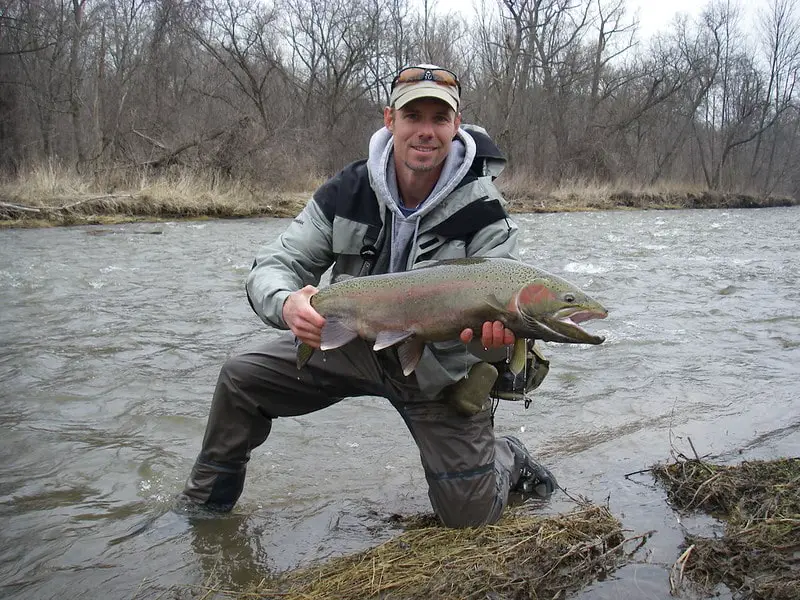
As a fishing guide for trout, steelhead, and salmon, I consider only three methods to be effective enough that I will use them, and float fishing in New York is often the most effective method.
New York has many great steelhead and trout rivers, and float fishing works so well because you can keep your bait suspended in the strike zone for extended periods. This dramatically improves the number of fish you can catch.
I have guided for over 1000 days using the float fishing method for trout, salmon, and steelhead. There are some things I’ve learned over this time on the water that have greatly improved my client’s ability to catch more fish, and I share this info with you here.
What is float fishing?
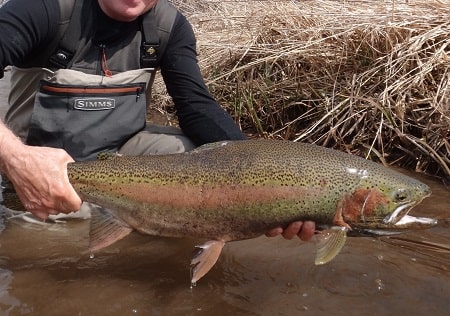
Float fishing generally refers to a fishing method where you suspend your bait below a specialized float or bobber designed for river fishing and allows the bait attached to drift naturally down the river following the current.
Float fishing is widely used and is the most effective steelhead, salmon, and trout fishing method.
As simple as it seems, there are certain complexities associated with this form of fishing, and I have discovered that the recipe for success comes down to 4 things.
- Speed Control
- Depth Control
- Presentation
- Bait Selection
What New York River Can You Float Fish?
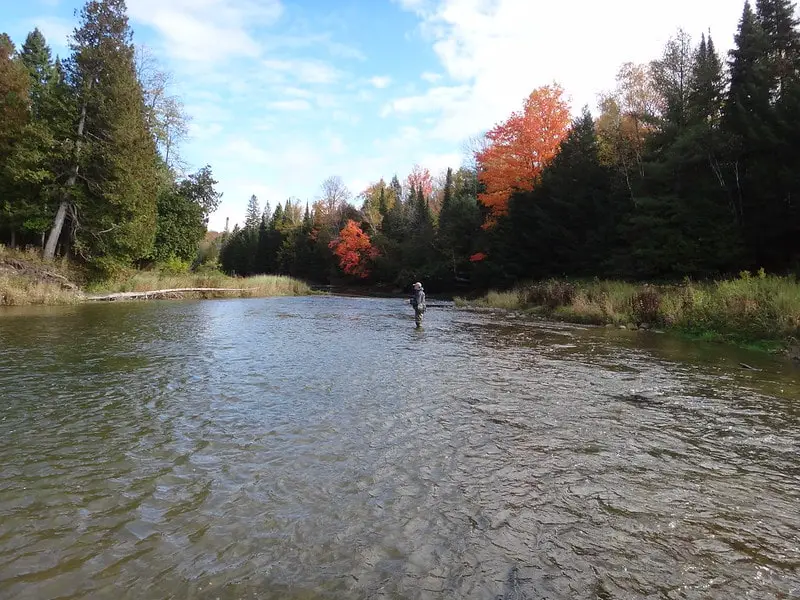
All New York rivers are suitable for float fishing. You need to ensure that you adjust your float fishing setup based on the type of water, which primarily means the current’s depth and velocity.
Float fishing is an excellent method on all types of waters, from fast to slow and deep to shallow rivers.
If the water is deeper than 3 feet deep and is shallower than 13 feet, it is good for float fishing.
Under 3 feet deep, especially if it is very clear, the float can spook the fish, and therefore, in this type of water, or in tiny pockets less than a few feet around, I will switch to bottom bouncing.
Float fishing is one technique that even an entry-level angler can easily figure out.
Reels For Float Fishing
If you are planning on float fishing for steelhead, trout, or salmon in New York, one of the most important things you will need is the right kind of float reel. Some reels are better than others for the float fishing method.
Generally, the commonly used types of float reels for fishing under a float are centerpin reels and spinning reels.
Centerpin Reels Are Best For Float Fishing
A Centerpin reel is a large round spool that sits on a center pin or post, giving it its name, the Centerpin. It is also called a float reel by many anglers.
Centerpin reels are characterized by extremely high-quality bearings that allow for free spool spin as the current pulls the float down the river.
Using a centerpin reel makes for very long, precise drifts without mending or feeding the line out. This greatly improves your ability to keep your bait in the strike zone for longer and improves your success.
Based on about 30 years of experience using Centerpin reels and comparing them to spinning reels and even baitcasting reels, I can honestly say that the Centerpin reel is the best reel for float fishing in any river.
Check out my recommendations for Centerpin reels.
Spinning Reels
Spinning reels are, in my opinion, the second-best reel for float fishing in the rivers of New York, and they are by far the most popular reel. I only use a spinning reel if my clients insist or if I need a multipurpose reel for other methods.
Even though the line does not come smoothly off the reel compared to a Centerpin reel, with practice, the spinning reel still maintains a good presentation.
The best spinning reels for New York float fishing should hold a large amount of line, provide good smooth drag, and a large smooth spool where the line is able to come off freely.
The spinning reel you use should also match the size of the river and the size of the fish.
I recommend a spinning reel of size 30 for most river and fishing conditions.
Float Rods For New York Rivers
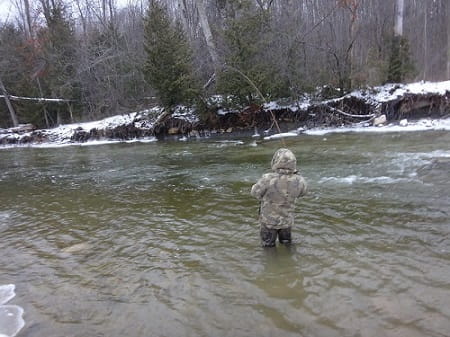
The importance of float rods in Steelhead fishing cannot be overemphasized. You use the rod to get a good presentation and fight big fish.
To increase your chances of success on the river, ensure that your float rod is the right length, weight, and stiffness for where you intend to fish.
Generally, long rods between 10 to 14 feet are best for float fishing in the streams and large rivers of New York. My go-to size is 13 foot rod.
The size of the river you’ll be fishing will determine the length of your rod; the larger the river, the longer the rod.
Basic Float Fishing Rig
Below is a quick visual on the basic float fishing setup or gear required outside the Rod or Reel.
Hooks For Steelhead
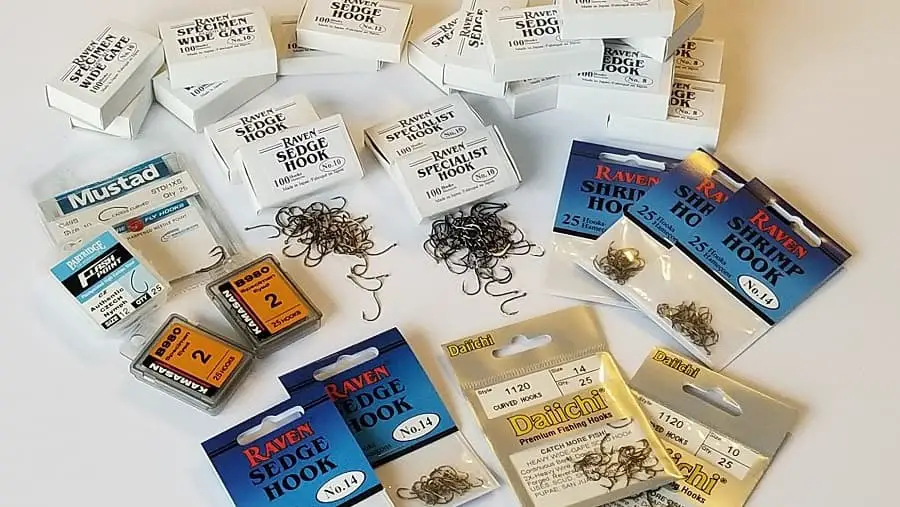
The best hooks will penetrate better and will hold on better.
I and other guides use only three or four types of hooks, but to keep it simple, my top two recommendations for float fishing hooks are the Raven Specimen Hook and the very popular Gamakatsu Octopus Hook.
The choice of your hook size will depend on the different water conditions, the size of the fish, and different baits.
As a rule of thumb, bigger hooks will be suited for bigger baits and smaller hooks for smaller baits and smaller fish.
Generally, a size 8 to 10 will work for most New York rivers for trout, steelhead, and salmon. I probably use size ten more than any other size.
However, all these are subject to personal preference. I discuss more on float fishing hooks on my page: 5 Best Hooks For Float Fishing: What The Guides Use.
Leader Line and Leader Setup
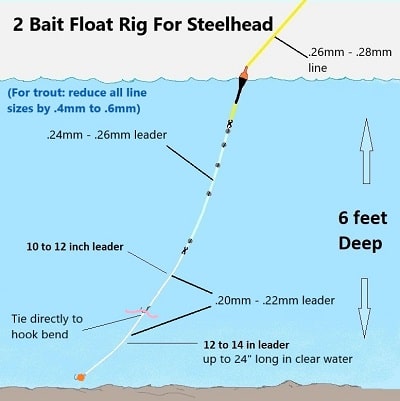
When it comes to leaders, you want a leader so light that the fish do not see it, yet heavy enough that the larger fish do not keep breaking you off.
Through years of experience, this is what I have found to be best in New York:
I only use fluorocarbon leaders, and I use two sizes on my leader setup.
- Trout Fishing: 3 to 4-pound leader
- Steelhead Fishing: Clear water, smaller rivers: use 6 pounds (0.18mm) Best general purpose leader: 8 pounds (0.20mm) Large rivers, fast currents, large steelhead: 10 pounds (0.22mm)
- Salmon Fishing: Very clear water and small streams:10 pound (0.22mm), General purpose: 12 pounds (0.24mm), Fast water and large rivers: 14 pounds (0.25mm)
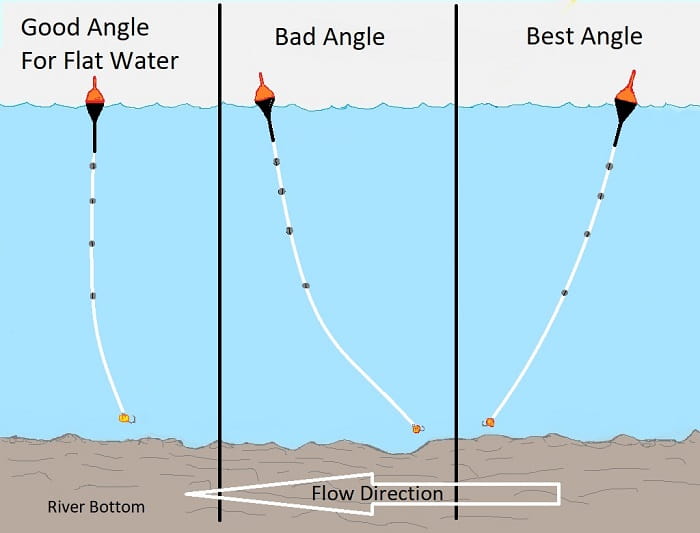
Generally, there are two sections (the shot line section and bottom section) of the leader setup, and you will need two different leader sizes. As a rule of thumb, the shot-line leader should be about two sizes heavier than the lower leader size.
Steelhead Leader Sizing Chart
Pound Test | Diameter Size | Method | River | Area |
6 pound | 0.007 in. / 0.18 mm | Float Fishing | - Small to Medium / Under 60 feet wide - Clear Water | Great Lakes |
8 pound | 0.008 in. / 0.20 mm | - Float Fishing - Bottom Bouncing - Plunking | - Small to Medium / Under 60 feet wide - Clear water | Great Lakes |
10 pound | 0.009 in. / 0.22 mm | - Float Fishing - Drift Fishing and Bottom Bouncing - Plunking | - Larger Great Lakes Rivers and faster currents - Off colored rivers - Small West Coast Rivers | Great Lakes and West Coast |
12 pound | 0.010 in. / 0.25 mm | - Lure Fishing Great Lakes - Float Fishing West Coast - Drift Fishing West Coast - Plunking on West Coast | - Large Great Lakes Rivers - Small to Medium West Coast Rivers | Great Lake and West Coast |
14 pound | 0.011 in. / 0.28mm | - Float Fishing on West Coast - Drift Fishing on West Coast | Medium to Large Rivers | West Coast |
16 pound | 0.012 in. / 0.31mm | Lure Fishing | Large to XL | West Coast |
Swivels
The swivel helps to untwist the line during line retrieval. This way, you would prevent undesirable tangling of the line, which can lead to its weakening.
The Floats
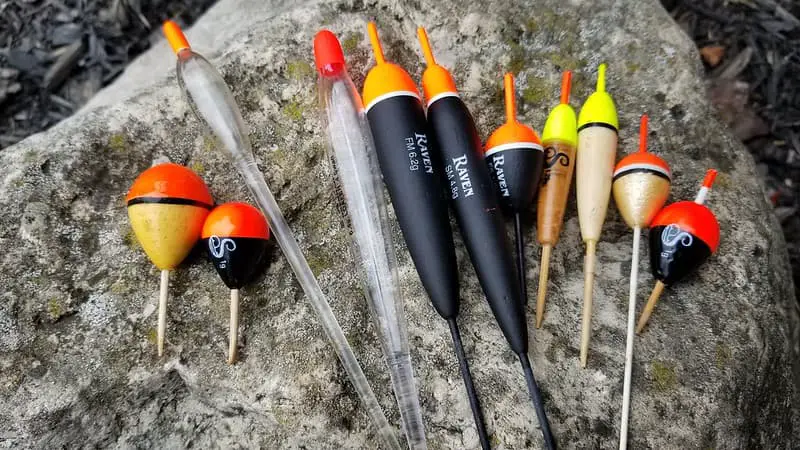
The right float will help you control your speed, gauge your depth, and ultimately catch more trout, steelhead, and salmon.
You need a float that is suitable for the type of water you intend to fish, whether in terms of the depth and size of the river. My go-to floats are:
In water deeper than my rod is long, I will switch to a slip float, which, if set up properly, will enable me to fish spots even over 20 feet deep. Otherwise, when float fishing in water 3 to 10 feet deep, I always use what is known as a fixed float.
Drennan Loafer Floats: Best for clear water and slow water. Raven FM Floats: great for most general float fishing situations.
You can learn more on how to choose the best floats for your float fishing by checking out my page on 5 Best Centerpin Floats.
Split Shots / Weights
I only use round split shots that are dark in color. I do NOT use the shiny weights or the ones with the little removable wings.
Best Baits
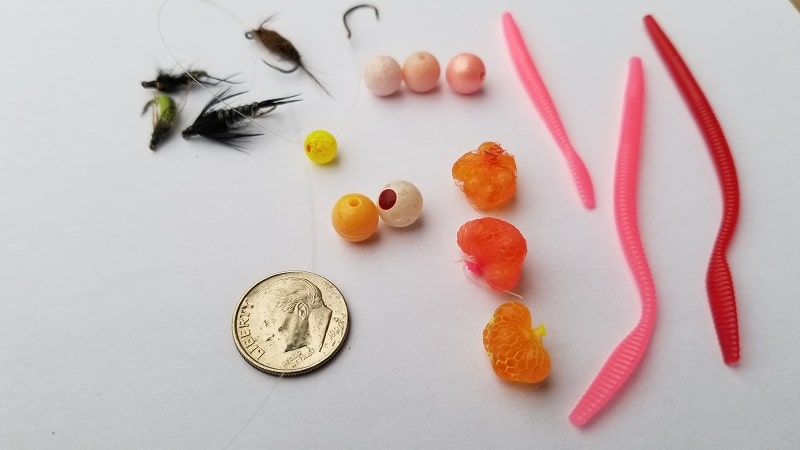
I choose my baits based on the conditions, and at certain times of the year or under certain water conditions, a normally effective bait might not be.
For this reason, I always have multiple good baits with me, and I rotate through the baits, sizes, and colors to figure out which baits are going to trigger a strike response.
Consider these baits:
- Salmon Eggs and Trout Eggs: At certain times of the year, this is an effective bait for trout, steelhead, and salmon.
- Worms: Worms are generally effective in spring, but they can also be effective all year.
- Artificial Flies: Artificial flies, the kind the fly fishermen use, can be effective at any time of the year, and at times, they are the most effective.
- Live baits: This can include insects like crickets, hellgramites, stoneflies, beetles, mealworms, grubs, minnows, leeches, crayfish, etc.
- Artificial baits: This can include plastic imitations of the above baits as well as baits like Powerbait Doughs.
Tips To Catch 10 Times More Fish On New York Streams
There is a simple formula for success when it comes to float fishing, and if you screw up even part of it, you will struggle to catch fish.
I have said many times that well-presented bait dramatically improves the possibility of a hookup, but so does each part of the formula, and if other parts of the formula are wrong, even an excellent presentation won’t work.
If your presentation and your hook are perfect, but the leader is so thick the fish see it, you will struggle.
If you use the perfect setup and the most effective bait, but your speed or depth is off, you will struggle.
Think about it: if everything is perfect and you have a great bait on the line, but that bait is five feet above the fish’s heads, and the fish are only willing to move two feet for a bait, everything that is perfect is useless because your bait is too far for them.
I’m saying that each part of the formula needs to be perfect or the other parts will not be as effective.
I’ve often said that speed control is the most critical part of your presentation, and I say this from experience.
I discuss speed control, depth finding, and how to set your float depth, as well as baits and leader setups, on these pages:
Regulations and Rules
Be sure to visit the New York DNR website to check the regulations for fishing the species and rivers you are targeting.
Tight Lines,
Graham

Can you use a slip float even in shallower water like 3 – 6 feet range?
Hi David,
You sure can use them in shallow water, some angler like slip floats for all water depths, however, I’m not a fan of them for various reasons which is why I only use them in deep water situations.
Graham